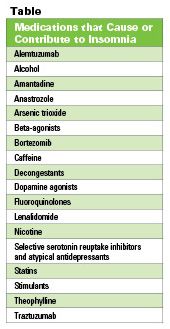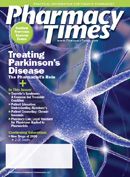Patient Counseling: Chronic Insomnia
Insomnia is a frustrating condition that affects 40% of adults at some time in their life. After obtaining a good patient history, pharmacists can counsel individuals on the behavioral and pharmacologic options for treatment.
Dr. Zanni is a psychologist and a health systems consultant, Alexandria, Virginia.
Insomnia. It is one of the few medical terms that has crossed into everyday use; most adults have had periods of difficulty falling asleep, trouble staying asleep, or poor quality sleep. A few nights of insomnia— the acute or short-term sleep disruption usually associated with stress or schedule disruptions like travel, or middle of the night emergencies—can be disruptive and distracting, but when insomnia lasts more than a month, it is considered chronic and can have serious health repercussions if untreated. Chronic insomnia is often related to behavioral factors or the effects of chronic illness, be it psychological or medical.1
Epidemiology
Insomnia remains the most prevalent sleep disorder in the population, with up to 40% of adults reporting insomnia at some point in their lives.2 Most individuals who experience insomnia symptoms “weather the storm” and do not seek treatment. Risk factors include female sex, increasing age, comorbid medical or psychiatric conditions, recent separation or divorce, lower socioeconomic status, and stressful times.2,3 About half of those who have insomnia report continuing symptoms at 1 year or more, and many experience symptoms for years.4-6 Insomnia is an independent risk factor for development of depression throughout life,7,8 and when it occurs with depression, it is an indicator that the patient is more likely not to respond to treatment.9,10
Evaluation
Treating chronic insomnia effectively begins with obtaining a good history from the patient that elucidates predisposing (family/genetic predisposition and chronic mental or medical disorders), precipitating (acute, stressful events or experiences), and perpetuating (behavioral patterns and medical issues or medication) factors. It should include current symptoms, sleep habits, and patterns of sleep and wakefulness. 11,12 Note that patients with chronic insomnia rarely complain of daytime sleepiness or a tendency to fall asleep in inappropriate places. Rather, they may mention irritability and mood lability, fatigue, or difficulty concentrating.
Clinicians need to ask pointed questions about usual bedtime, morning rising, how sleep differs on each day of the week (eg, workdays vs weekends), and patients’ feelings about sleep. Bed partners may be good sources of information about possible snoring or breathing pauses that might suggest sleep apnea, and motor restlessness and involuntary leg movements that might suggest restless legs syndrome.10 Some clinicians find that asking the patient to keep a sleep diary for 2 weeks can be very useful. (The National Sleep Foundation provides a free sleep diary.)
A number of psychiatric disorders— especially mood, anxiety, psychotic, and substance abuse disorders—are associated with chronic insomnia. Many chronic medical disorders also cause insomnia, including heart failure, coronary artery disease, stroke, Parkinson’s disease, cerebrovascular disease, chronic renal failure, prostatic hypertrophy, diabetes, hyperthyroidism, obesity, arthritis, fibromyalgia, and menopause. Clearly, disorders that cause pain, restrict mobility, or affect breathing lead the list. The Table lists medications and substances that also cause or contribute to insomnia.
Psychological and Behavioral Treatment
All patients who have chronic insomnia should be educated about psychological or behavioral modification. Basic interventions include:
• Avoiding caffeine and nicotine
• Exercising early in the day
• Establishing regular sleep hours, and rising at about the same time each morning
• Darkening the bedroom, and keeping it cool
• Limiting time in bed to actual sleep hours, and avoiding working or studying in bed
• Leaving the bed and pursuing quiet activity if sleep does not come, so frustration at not sleeping does not perpetuate the problem; returning to bed when drowsy
Patients often self-medicate when they cannot sleep, frequently using alcohol or antihistamines. Alcohol is a poor choice, as it may help promote sleep initially, but disrupts sleep for the remainder of the night. Its chronic use is also a concern. Diphenhydramine and other antihistamines can help patients sleep, but are strongly anticholinergic; other side effects can be troublesome. Alternative supplements like valerian are also used.
Pharmacologic Treatment
Since the 1970s, benzodiazepine receptor agonists (BzRAs) have been the standard of care for adult insomnia that does not respond to behavioral changes and non-drug interventions. Their short-term safety and effectiveness represents an improvement over barbiturates; consequently, regulators have approved these drugs for shortterm use. The FDA has approved 8 BzRAs and 1 melatonin receptor agonist for treatment of insomnia. Several barbiturate and nonbarbiturate drugs (eg, chloral hydrate, ethchlorvynol) are also approved as sedative-hypnotics, but used less often than the benzodiazepines. 13
All BzRAs—estazolam, eszoiclone, flurazepam, quazepam, temazopam, triazolam, zaleplon, and zolpidem— reduce sleep-onset latency and increase total sleep time, but they differ primarily in terminal elimination half-life ranging from 1 to 120 hours. Depending on the patient’s symptoms (difficulty falling asleep, difficulty staying asleep, or mid-night wakening), clinicians should select agents based on their duration of action. Each drug’s duration of action is related to its half-life.13

Adverse effects associated with BzRAs include anterograde amnesia, postural instability, and sleepiness.11,14 These effects may be related to the specific drug’s half-life; impaired memory and daytime sedation are more likely with agents having long half-lives. The lay press has reported some adverse behaviors, including sleep-related eating, sexual behavior, and driving. Most reports have been associated with zolpidem, but similar adverse effects are possible with any agent in this class.11,14
BzRAs may also be associated with rebound insomnia (especially with short-acting drugs), withdrawal, tolerance, and dependence. Gradual dose tapering can prevent or lessen rebound insomnia and withdrawal symptoms. Clinicians should monitor to ensure patients only take these drugs if they have therapeutic benefits.11,14
Ramelteon, a melatonin receptor agonist, seems to be better at reducing sleep-onset latency than eliminating wakefulness during the middle of the night. Adverse effects are rare, but may include some hormonal alterations (eg, reduced testosterone).15
Clinicians use a number of drugs with sedating effects that have not been specifically approved for insomnia in clinical practice: antidepressants (especially trazodone), antipsychotics, anticonvulsants, etc. Few trials support their use, but they offer an alternative for those patients who cannot use benzodiazepines, especially if the patient has comorbid depression, mental illness, or seizure disorder. Side effects like orthostatic hypotension and anticholinergic effects are of concern in the elderly. Some of these drugs have metabolic and neurologic side effects, so care is warranted.
Counseling
Educate patients about realistic expectations:
• Some degree of night-to-night variability in sleep quality is natural, even with treatment.
• Treatment should improve their sleep and daytime functioning.
• If behavioral interventions fail, pharmacologic treatment may be appropriate when insomnia causes distress or impairment.
• Side effects may occur, and patients should be warned, especially if they are elderly.
Final Thought
Chronic insomnia should be carefully evaluated, beginning with a thorough clinical history, including sleep habits and patterns. The possibility of other sleep disorders, comorbidity with another medical or psychiatric disorder, and the effects of substances and medications should be considered in patients with insomnia. Treatments for insomnia include psychological and behavioral treatments and pharmacotherapy, which can be used in combination. â–
References
1. National Institutes of Health State of the Science Conference Statement on Manifestations and Management of Chronic Insomnia in Adults, June 13—15, 2005. Sleep 2005; 28:1049–1057.
2. Ohayon MM: Epidemiology of insomnia: what we know and what we still need to learn. Sleep Med Rev 2002; 6:97—111.
3. Buysse DJ, Germain A, Moul DE: Diagnosis, epidemiology, and consequences of insomnia. Prim Psychiatry 2005; 12:37—44.
4. Buysse DJ, Angst J, Gamma A, Ajdacic V, Eich D, Rössler W: Prevalence, course, and comorbidity of insomnia and depression in young adults. Sleep 2008; 31:473—480http://ajp.psychiatryonline.org/cgi/external_ref?access_num=18457234&link_type=MED.
5. Foley DJ, Monjan A, Simonsick EM, Wallace RB, Blazer DG: Incidence and remission of insomnia among elderly adults: an epidemiologic study of 6,800 persons over three years. Sleep 1999; 22(suppl 2):S366—S372.
6. Moul DE, Nofzinger EA, Pilkonis PA, Houck PR, Miewald JM, Buysse DJ: Symptom reports in severe chronic insomnia. Sleep 2002; 25:553—563http://ajp.psychiatryonline.org/cgi/external_ref?access_num=12150322&link_type=MED.
7. Perlis ML, Smith LJ, Lyness JM, Matteson SR, Pigeon WR, Jungquist CR, Tu X: Insomnia as a risk factor for onset of depression in the elderly. Behav Sleep Med 2006; 4:104—113.
8. Buysse DJ, Tu XM, Cherry CR, Begley AE, Kowalski J, Kupfer DJ, Frank E: Pretreatment REM sleep and subjective sleep quality distinguish depressed psychotherapy remitters and nonremitters. Biol Psychiatry 1999; 45:205—213.
9. Nierenberg AA, Keefe BR, Leslie VC, Alpert JE, Pava JA, Worthington JJ, Rosenbaum JF, Fava M: Residual symptoms in depressed patients who respond acutely to fluoxetine. J Clin Psychiatry 1999; 60:221—225.
10. Reynolds CF III, Frank E, Houck PR, Mazumdar S, Dew MA, Cornes C, Buysse DJ, Begley A, Kupfer DJ: Which elderly patients with remitted depression remain well with continued interpersonal psychotherapy after discontinuation of antidepressant medication? Am J Psychiatry 1997; 154:958—962.
11. Buysse DJ, Germain A, Moul D, Nofzinger EA: Insomnia, in Sleep Disorders and Psychiatry. Edited by Buysse DJ. Review of Psychia, vol 24. Arlington, Va, American Psychiatric Publishing, 2005, pp 29—75.
12. Spielman AJ, Anderson MW: The clinical interview and treatment planning as a guide to understanding the nature of insomnia: the CCNY Insomnia Interview, in Sleep Disorders Medicine: Basic Science, Technical Considerations, and Clinical Aspects. Edited by Chokroverty S. Boston, Butterworth-Heinemann, 1999, pp 385—416.
13. Bateson AN: The benzodiazepine site of the GABAA receptor: an old target with new potential? Sleep Med 2004; 5(suppl 1):S9—S15.
14. Walsh JK, Roehrs T, Roth T: Pharmacologic treatment of primary insomnia, in Principles and Practice of Sleep Medicine. Edited by Kryger MH, Roth T, Dement WC. Philadelphia, Elsevier Saunders, 2005, pp 748—760.
15. Erman M, Seiden D, Zammit G, Sainati S, Zhang J: An efficacy, safety, and dose-response study of ramelteon in patients with chronic primary insomnia. Sleep Med 2006; 7:17—24.

